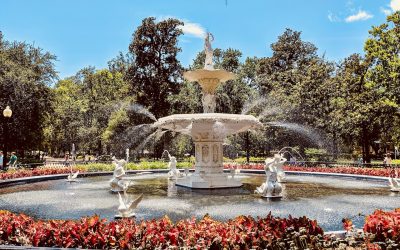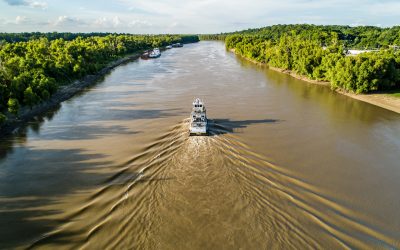Have you ever heard about a man named Blackbeard? His real name was Edward Teach and he was born in England. He grew up to be one of the most infamous pirates that ever lived. He had a long black beard that reached his waist. In the 1700s, he spent his time ransacking ships, stealing everything valuable on board, throughout the West Indies and along the eastern coast of the United States, then known as the British colonies. In the later years of his life, he called North Carolina his home.
Do you know where North Carolina is? It’s one state south of Virginia, east of Tennessee, above or north of South Carolina, and west of the Atlantic Ocean. Georgia, another state, is on its southwestern border.
The state features three unique regions:
- The Appalachian Mountains: the range is divided into two sections called the Great Smokies and the Blue Ridge Mountains. This is the largest mountain range in the eastern United States, which covers the state’s western region. Some peaks are more than a mile above sea level!
- Piedmont Region: This area is high and flat, like a mountain with its top chopped off! It sits between the mountain and coastal plain regions. Rivers also flow through waterfalls and over rapids.
- Eastern Region: Can you hear the seagulls? This coastal plain is mostly flat land that leads to the Atlantic Ocean. Beaches, swamps and longleaf pines make up the landscape here.
Hundreds of years ago, North and South Carolina were actually one colony called simply: Carolina. King Charles II of England named the territory in honor of his father, Charles I. The word “Carolina” comes from the Latin name Carolus, which is translated as Charles. But in 1712, the territory split. North and South Carolina were permanently divided. Here’s why.
Besides Blackbeard, there are many fun and interesting things to learn about this state. Here’s a few facts to get you started:
- Like sweet potato fries? Because the land is rich and the climate is hot and moist, North Carolina grows more sweet potatoes than any other US state. It produces more than half (about 60 percent!) of all the sweet potatoes in this country.
- The state is the birthplace of Pepsi-Cola. Read the section below, “Tell Me More,” to learn who created it and why.
- Putt-putt golf was created here as an alternative to golf. Likewise, read more about it in the “Tell me more” section below.
What really happened
- Hunters and gatherers lived in this area at least 10,000 years ago. What do you think they ate? How were they dressed? Do you think kids went to school? Over the years, the Cherokee, Woodland, Mississippian, and other Native American tribes called the area home.
- Europeans first came here in the 1500s. In 1789, North Carolina became the 12th of the original 13 colonies (or states) to join the Union after America declared its independence from Great Britain.
- The first permanent settlement in North Carolina was established by Virginians in the mid-1600s. English King Charles II granted the Carolina regions to eight Englishmen in 1663. Soon, more British moved into the area.
- North Carolina became a royal colony in 1729. But, during the American Revolution (1775-1783), people’s loyalties were divided. Who should they support: Britain or the new United States of America? The British government was overthrown in 1775. North Carolina then joined the Union as the 12th
- In 1759, smallpox swept through the Catawba (Native American tribe) villages for a fourth time in a century bringing the population of the nation to less than 1,000 by 1760. Smallpox killed an estimated 90% of Native Americans. It is believed to have arrived in the Americas in 1520 on a Spanish ship sailing from Cuba, carried by an infected African slave.
- In 1861, North Carolina split, or seceded, from the country. It fought against the Union during the Civil War and became one of 11 states that made up the Confederate States of America.
- In 1903, the Wright Brothers (Wilbur and Orville Wright) made the first successful flight on a mechanically powered airplane in Kitty Hawk, North Carolina. That’s why the state’s license plates read “First in Flight” and its quarters read “First Flight”.
Stuff you should know
- One of the state’s nicknames is the Tar Heel State. Hundreds of years ago, workers living here sold tar, pitch and turpentine from the state’s longleaf pine trees that were used in wooden ships. Legend has it that some British soldiers were slowed down when they stepped in sticky North Carolina tar during the Revolutionary War.
- In 1799, a 12-year-old boy named Conrad Reed was fishing when he noticed something shiny in the waters of Little Meadow Creek. He took the 17-pound yellow rock out of the water and carried it home. According to historians, it was the first gold discovered in this country.
- Off North Carolina’s coast is a long chain of islands and sandy reefs called the Outer Banks. Three capes named Cape Hatteras, Cape Lookout, and Cape Fear jut into the ocean in a region known as the Graveyard of the Atlantic. Many ships sunk in these treacherous waters, which also claimed the lives of many sailors.
- Fort Bragg, just west of Fayetteville, is the largest US Army base in the country.
- The Research Triangle in Piedmont is the largest research park in the country. Three major research-based universities (Duke, the University of North Carolina at Chapel Hill, and North Carolina State University) meet in a triangular shape. The area is also referred to as the Raleigh-Durham-Chapel Hill part of North Carolina.
- Three presidents have come from North Carolina: James Polk (11th US president); Andrew Jackson (seventh US president), and Andrew Johnson (17th US president).
Funny, crazy, or just plain weird
- Dellview, North Carolina only has 25 residents (as of the 2020 census). It’s among the smallest towns in the state and country.
- The Biltmore Estate in Asheville, North Carolina is the largest mansion in the United States. It has 255 rooms, gardens, and a winery.
- Want to try a new soft drink? Cheerwine, made in Salisbury, North Carolina in 1917, has a unique & fizzy wild cherry taste. But don’t let the name fool you – it is safe and legal for kids to drink!
- Emeralds naturally occur in the state and are so abundant that it was named the state stone in 1973. You can even mine this precious gem at Emerald Hollow Mine.
- Off the coast of North Carolina is a place called Bald Head Island(due to erosion, the land resembles a bald head). Cars are banned on the island.
Tell me more
- Caleb Davis Bradham was a medical student from North Carolina who worked as an apprentice at a local drugstore. A family crisis, however, forced him to drop out and move back to New Bern, where he opened up his own drugstore. In 1893, he created a drink to aid digestion which was known as “Brad’s drink” – it became a hit and is known today as Pepsi.
- North Carolina is one of the largest producers of furniture in the country.
- A person who is from or lives in North Carolina is called a North Carolinian.
- In 1954, Don Clayton created Putt-Putt golf in Fa Putt-Putt is a fun, obstacle-filled golf course, an alternative to the traditional sport of golf.
- According to the 2020 US Census, more than 120,000 Native Americans live in the state. There are at least eight state-recognized tribes in the region, including the eastern band of Cherokee and Coharie.
Whether you live in or have ever visited the state, we want to hear your stories about North Carolina’s geography or history! Email info@adventuresofmo.com along with your first name, age and state you live in, and we’ll post your North Carolina story on Mo’s social media pages!







